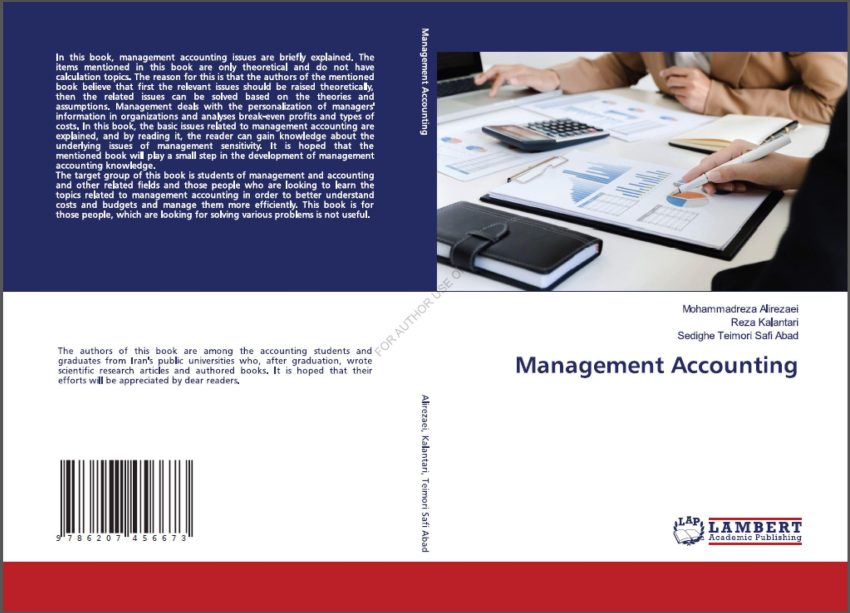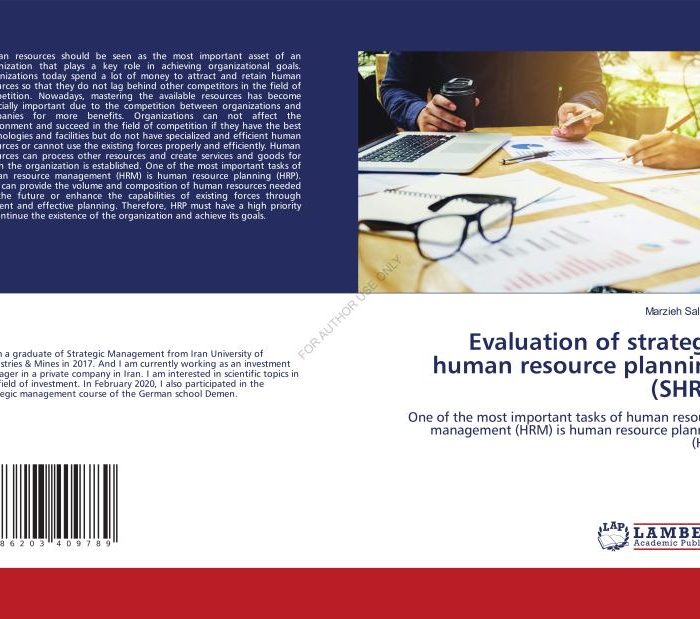کتاب Management Accounting
۳۸۴,۰۰۰ تومان قیمت اصلی: ۳۸۴,۰۰۰ تومان بود.۱۹۲,۰۰۰ تومانقیمت فعلی: ۱۹۲,۰۰۰ تومان.
| تعداد صفحات | 127 |
|---|---|
| شابک | 978-620-7-45667-3 |
| انتشارات |



کتاب Management Accountings – راهنمایی جامع در حسابداری مدیریت
کتاب Management Accountings به عنوان یکی از منابع مهم در حوزه حسابداری مدیریت، ابزارها و تکنیکهای پیشرفتهای را برای تحلیل مالی، تصمیمگیری استراتژیک، و مدیریت منابع سازمانی ارائه میدهد. این کتاب یک راهنمای عملی برای مدیران، حسابداران و دانشجویان است که به دنبال درک بهتر از نقش حسابداری در مدیریت سازمان هستند.
درباره کتاب Management Accountings
این کتاب به بررسی مفاهیم پایه و پیشرفته حسابداری مدیریت میپردازد و نقش آن را در بهبود عملکرد سازمانها توضیح میدهد. نویسنده با تکیه بر مثالهای واقعی و مطالعات موردی، کاربردهای مختلف حسابداری مدیریت در تحلیل هزینهها، بودجهریزی، و تصمیمگیریهای اقتصادی را به تصویر کشیده است.
موضوعات کلیدی کتاب
- اصول حسابداری مدیریت: توضیح مفاهیم اولیه و کاربردهای عملی در سازمانها.
- بودجهریزی و کنترل مالی: تکنیکهای موثر برای تدوین بودجه و مدیریت منابع مالی.
- تحلیل هزینه و سود: بررسی روشهای مختلف برای تحلیل هزینهها و ارزیابی عملکرد سازمان.
- تصمیمگیری استراتژیک: نقش حسابداری مدیریت در تعیین استراتژیهای کسبوکار.
- مطالعات موردی: ارائه مثالهای واقعی از چالشها و راهکارهای مدیریت مالی.
ویژگیهای برجسته کتاب Management Accountings
- رویکرد جامع: پوشش تمامی جنبههای حسابداری مدیریت، از مبانی تا موضوعات پیشرفته.
- زبان ساده و کاربردی: مناسب برای افراد با سطوح مختلف دانش در حسابداری و مدیریت.
- تمرکز بر کاربردهای عملی: ارائه راهکارهای عملی برای مسائل روزمره سازمانها.
- مطالعات واقعی: استفاده از مثالهای کاربردی برای درک بهتر مفاهیم.
چرا کتاب Management Accountings را بخوانید؟
اگر به دنبال یادگیری تکنیکهای پیشرفته حسابداری مدیریت برای بهبود تصمیمگیریهای مالی و استراتژیک هستید، این کتاب یک منبع ارزشمند برای شما خواهد بود. این کتاب بهویژه برای مدیران، حسابداران و افرادی که به دنبال تقویت دانش خود در حوزه مدیریت مالی هستند، پیشنهاد میشود.
مخاطبان کتاب Management Accountings
- مدیران مالی و اجرایی: برای بهبود تصمیمگیریهای استراتژیک و مدیریت منابع.
- حسابداران حرفهای: برای توسعه دانش و مهارتهای خود در حوزه حسابداری مدیریت.
- دانشجویان رشتههای حسابداری و مدیریت: به عنوان یک منبع جامع و کاربردی.
- مشاوران مالی و اقتصادی: برای ارائه راهکارهای موثر به مشتریان و سازمانها.
سفارش کتاب Management Accountings
برای خرید کتاب Management Accountings و آغاز سفری در دنیای حسابداری مدیریت و تصمیمگیری مالی، به بخش فروشگاه سایت مراجعه کنید یا با ما تماس بگیرید. این کتاب ابزاری کارآمد برای بهبود عملکرد مالی و مدیریتی سازمان شما خواهد بود.
📘 پرسش و پاسخ درباره کتاب Management Accounting
🔹 بخش اول: مقدمهای بر حسابداری مدیریت
❓ ۱. حسابداری مدیریت چیست؟
🔹 حسابداری مدیریت به فرآیند جمعآوری، تحلیل و تفسیر اطلاعات مالی برای کمک به مدیران در تصمیمگیریهای تجاری و بهبود عملکرد شرکتها اشاره دارد.
❓ ۲. تفاوت حسابداری مالی با حسابداری مدیریت چیست؟
🔹 حسابداری مالی به ثبت و گزارشدهی وضعیت مالی شرکت به ذینفعان خارجی (مانند سرمایهگذاران و مقامات مالیاتی) میپردازد، در حالی که حسابداری مدیریت بیشتر متمرکز بر اطلاعاتی است که به تصمیمگیریهای داخلی و عملیاتی کمک میکند.
❓ ۳. روشهای سنتی در مقابل روشهای نوآورانه در حسابداری چیست؟
🔹 روشهای سنتی به شیوههای قدیمی و مبتنی بر ثبت دستی و گزارشهای ثابت اشاره دارند، در حالی که روشهای نوآورانه مانند تجزیه و تحلیل دادههای بزرگ (Big Data) و استفاده از فناوریهای ابری، به شرکتها کمک میکنند تا سریعتر و مؤثرتر تصمیمگیری کنند.
🔹 فصل دوم: ویژگیهای اطلاعات حسابداری
❓ ۴. ویژگیهای کیفی اطلاعات حسابداری چیست؟
🔹 ویژگیهای کیفی اطلاعات حسابداری شامل قابلیت اتکا، قابل فهم بودن، مقایسهپذیری و به موقع بودن است که به تصمیمگیرندگان کمک میکند تا تصمیمات درستی بگیرند.
❓ ۵. چرا ویژگیهای کیفی اطلاعات حسابداری مهم هستند؟
🔹 این ویژگیها برای اطمینان از اینکه اطلاعات حسابداری صحیح، شفاف و قابل استفاده در فرایندهای تصمیمگیری هستند، ضروری است.
❓ ۶. حسابداری مدیریت چگونه به تصمیمگیری کمک میکند؟
🔹 حسابداری مدیریت ابزارهایی برای تجزیه و تحلیل اطلاعات مالی ارائه میدهد که به مدیران کمک میکند تا تصمیمات استراتژیک و عملیاتی مؤثری اتخاذ کنند.
🔹 فصل سوم: چالشها و فرصتها در حسابداری مدیریت
❓ ۷. چالشها و فرصتهای حسابداری مدیریت چیست؟
🔹 چالشها شامل استفاده ناکافی از دادههای بزرگ، امنیت ناقص سیستمهای اطلاعاتی در شرکتها و مشکلات در پیادهسازی فناوریهای نوین مانند محاسبات ابری هستند. فرصتها شامل بهبود امنیت اطلاعات و استفاده از فناوریهای جدید برای تجزیه و تحلیل دادهها هستند.
❓ ۸. مزایای استفاده از دادههای بزرگ چیست؟
🔹 دادههای بزرگ میتوانند به شرکتها کمک کنند تا الگوهای جدید در عملکردهای تجاری شناسایی کنند، به پیشبینی دقیقتر روندهای آینده بپردازند و تصمیمگیریهای استراتژیک بهتری داشته باشند.
🔹 فصل چهارم: استراتژیهای حسابداری مدیریت
❓ ۹. حسابداری مدیریت استراتژیک چیست؟
🔹 حسابداری مدیریت استراتژیک به استفاده از اطلاعات حسابداری برای پشتیبانی از تصمیمات بلندمدت و استراتژیک در جهت بهبود عملکرد کلی سازمان اشاره دارد.
❓ ۱۰. عوامل ممکن در حسابداری مدیریت استراتژیک چیست؟
🔹 عواملی مانند تحلیل هزینهها، تحلیل رقبا، و درک روندهای بازار میتوانند بر تصمیمات حسابداری مدیریت استراتژیک تأثیر بگذارند.
🔹 بخش دوم: حسابداری هزینهها
❓ ۱۱. حسابداری هزینهها چیست؟
🔹 حسابداری هزینهها به فرآیند شناسایی، اندازهگیری و تجزیه و تحلیل هزینههای مربوط به تولید کالاها و خدمات اشاره دارد.
❓ ۱۲. تفاوت حسابداری هزینهها با حسابداری مالی چیست؟
🔹 حسابداری هزینهها متمرکز بر شناسایی و تخصیص هزینههای مربوط به تولید است، در حالی که حسابداری مالی بیشتر به ثبت و گزارشدهی اطلاعات مالی به ذینفعان خارجی پرداخته و جنبههای مالی کلی شرکت را تحلیل میکند.
🔹 فصل پنج: کاربرد حسابداری هزینهها در مدیریت
❓ ۱۳. حسابداری هزینهها چگونه در مدیریت به کار میآید؟
🔹 حسابداری هزینهها به مدیران کمک میکند تا درک دقیقی از هزینههای تولید، سودآوری هر بخش از کسبوکار و بهرهوری کلی سازمان داشته باشند.
❓ ۱۴. انواع گزارشهای حسابداری هزینهها چیست؟
🔹 گزارشهای مختلفی شامل گزارش موجودی مواد خام، هزینههای تولید، هزینههای نهایی محصول و ضایعات تولیدی وجود دارند که اطلاعات مهمی برای تصمیمگیریهای مدیریتی فراهم میکنند.
🔹 نتیجهگیری
❓ ۱۵. نتیجهگیری کتاب چیست؟
🔹 این کتاب نشان میدهد که حسابداری مدیریت و حسابداری هزینهها ابزارهای حیاتی برای تصمیمگیریهای استراتژیک و عملیاتی در سازمانها هستند. با استفاده از روشهای نوآورانه و تحلیلهای دقیق هزینهها، میتوان عملکرد کسبوکار را بهبود بخشید.
📌 این مجموعه پرسش و پاسخ، نکات مهم و کلیدی کتاب Management Accounting را به صورت خلاصه ارائه میدهد. امیدواریم برای شما مفید باشد! 😊
| تعداد صفحات | 127 |
|---|---|
| شابک | 978-620-7-45667-3 |
| انتشارات |
محصولات مشابه
-
کتاب Evaluation of strategic human resource planning (SHRP)
۲۹۱,۰۰۰ تومانقیمت اصلی: ۲۹۱,۰۰۰ تومان بود.۱۷۳,۱۴۵ تومانقیمت فعلی: ۱۷۳,۱۴۵ تومان. -
کتاب Principles of Health Law
۸۸۸,۰۰۰ تومانقیمت اصلی: ۸۸۸,۰۰۰ تومان بود.۳۵۵,۲۰۰ تومانقیمت فعلی: ۳۵۵,۲۰۰ تومان. -
کتاب The Mystic Ladder
۴۹۲,۰۰۰ تومانقیمت اصلی: ۴۹۲,۰۰۰ تومان بود.۲۴۶,۰۰۰ تومانقیمت فعلی: ۲۴۶,۰۰۰ تومان. -
کتاب Principles of crisis management: Principles of crisis management in the organization and individual life
۳۹۰,۰۰۰ تومانقیمت اصلی: ۳۹۰,۰۰۰ تومان بود.۱۹۵,۰۰۰ تومانقیمت فعلی: ۱۹۵,۰۰۰ تومان.












